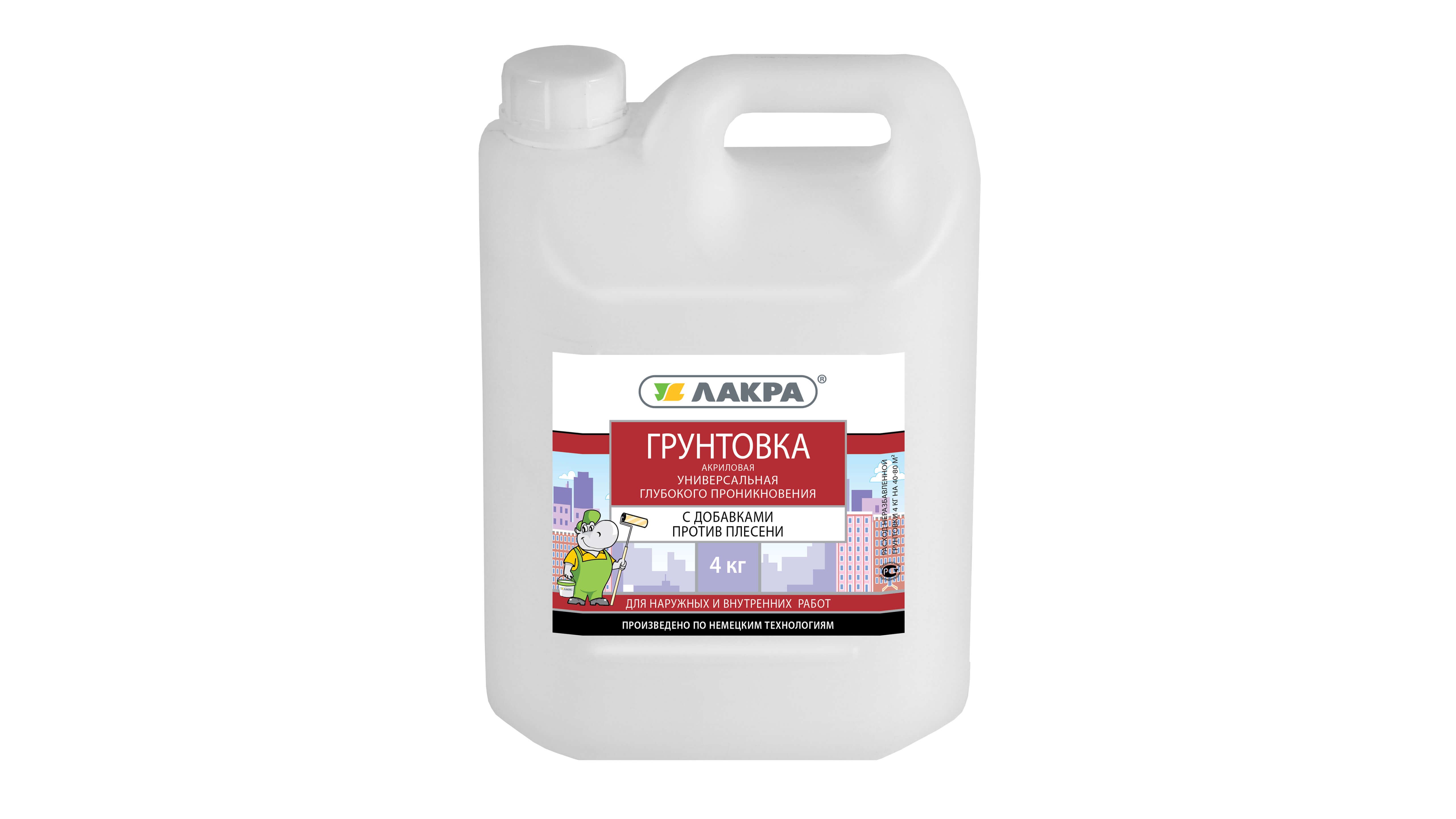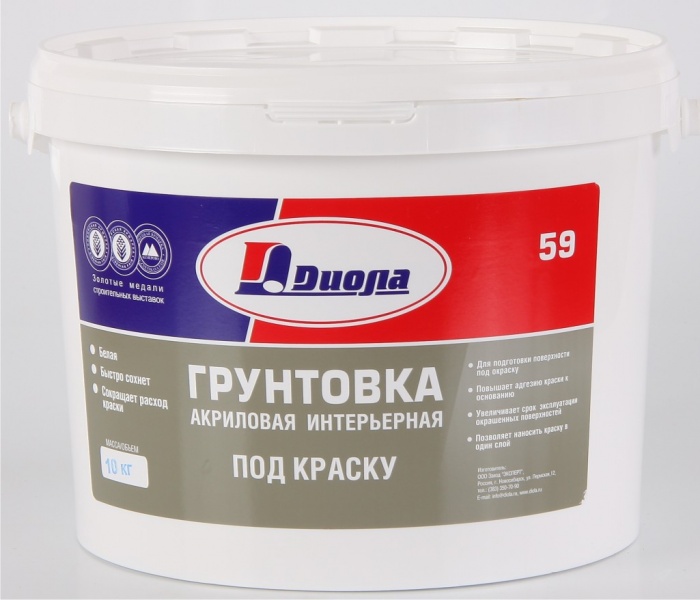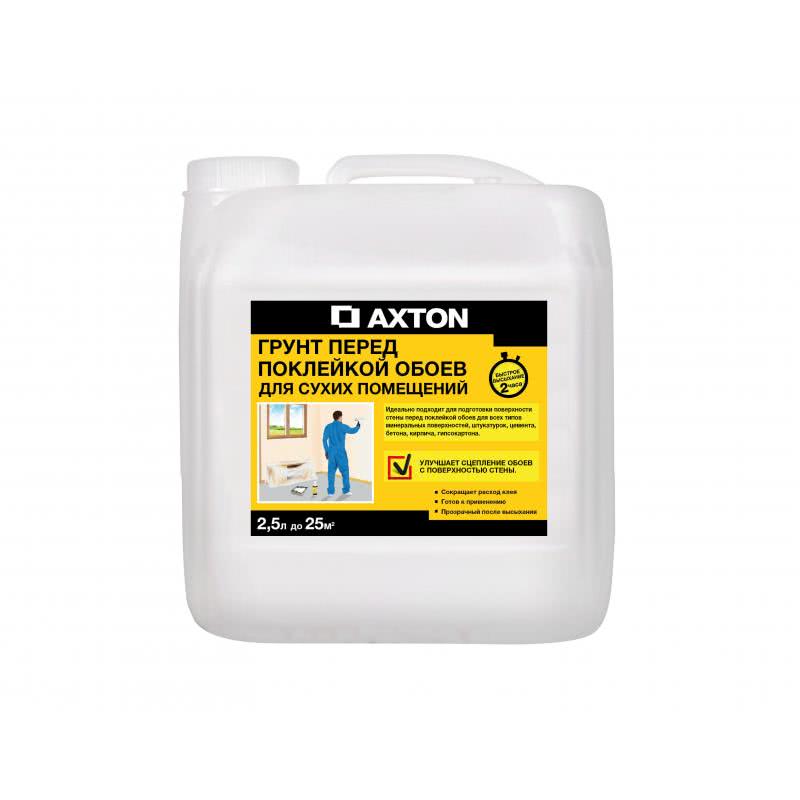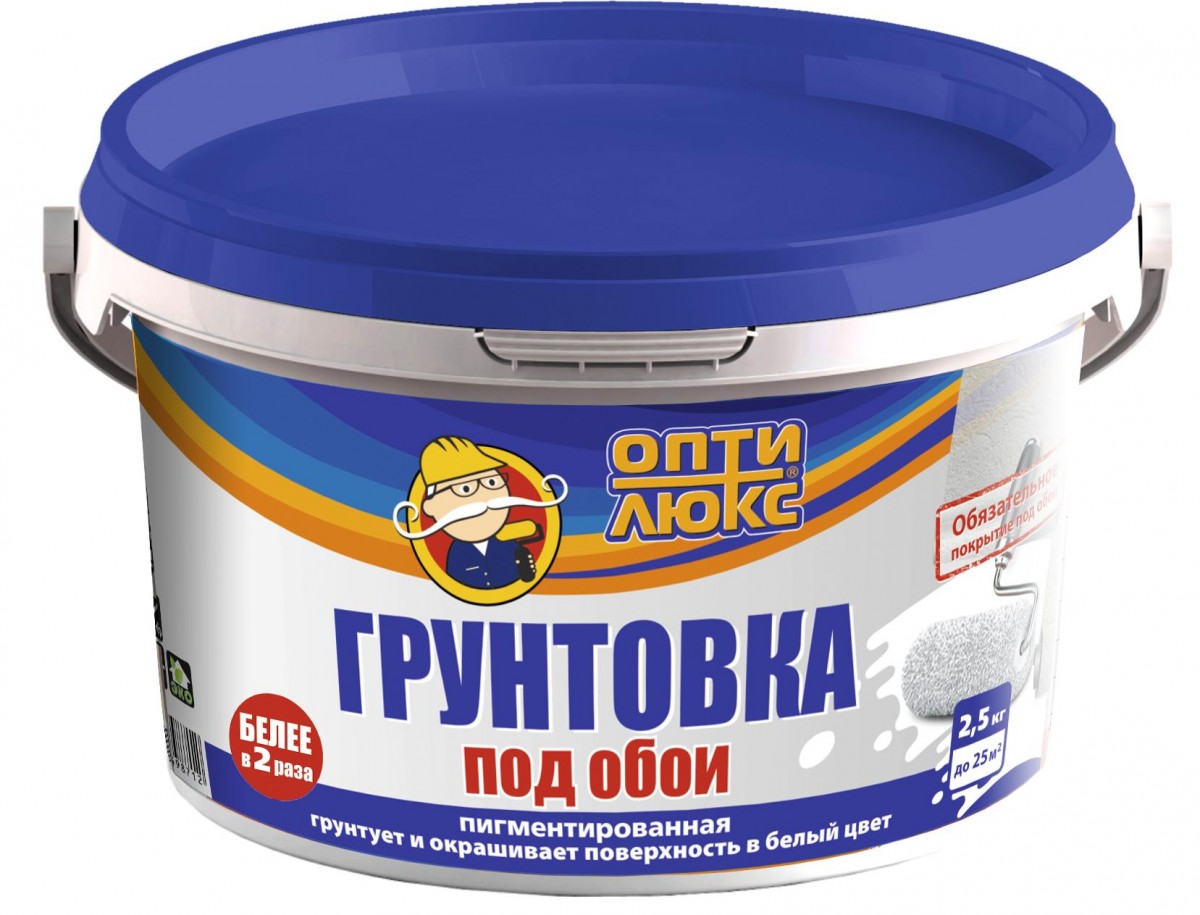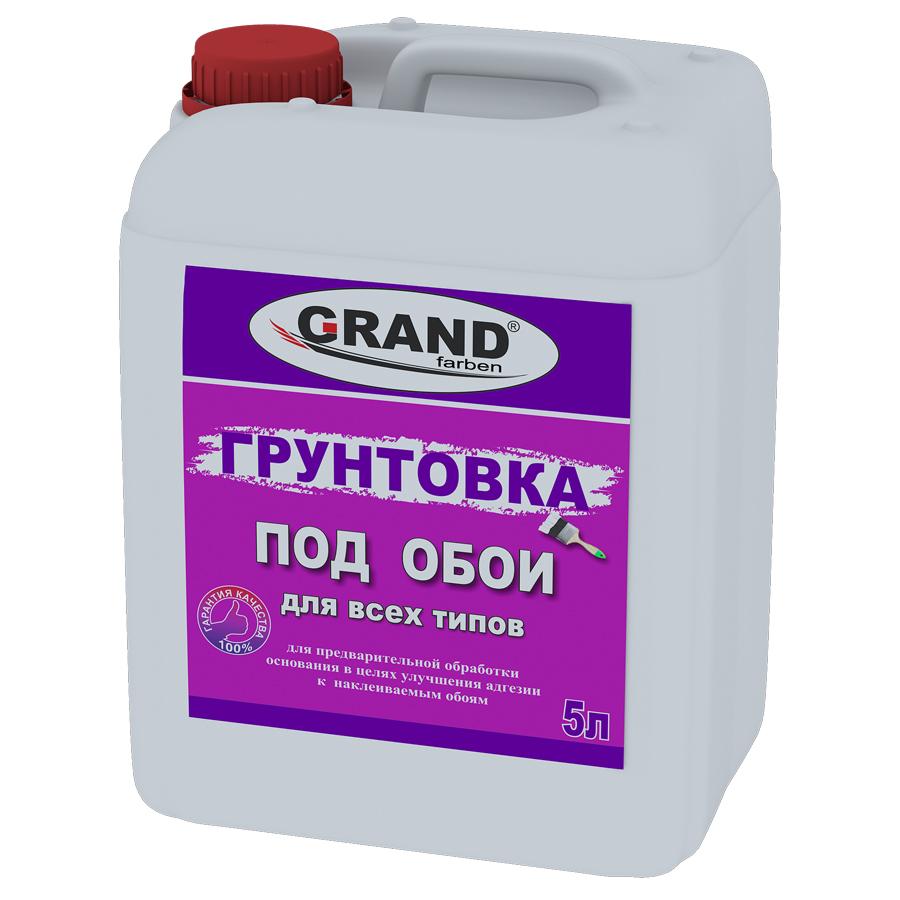# 1. What is a primer for?
This question is asked by everyone who is engaged in repairs, doubting that the soil is generally necessary. So what is a primer for and what does it consist of? The primer mixes include film-forming polymeric materials (resins, oils, adhesives), pigments, drying accelerators and various additives to impart the necessary qualities. Primers do not have decorative properties, they are used for coating with finishing materials, but, if necessary, can be tinted to simplify the process of applying the cladding.
Primers are available in the form of compounds or powders ready to be applied to the wall, which must be prepared according to the instructions. The composition can vary greatly depending on which surface the primer is intended for and what conditions will be in the room where it is used. Regardless of the composition, the functions of the primer remain unchanged:
- strengthening the surface, therefore, for loose, porous, uneven and weak substrates, the use of a primer is strictly necessary. For the most fragile surfaces, deep penetration primers are used, which "climb" into the thickness of the material by 8-10 cm, while conventional compounds penetrate only 2-3 cm;
- improving adhesion with the finishing material, which is the main function of the primer. With its help, roughness is removed, and the absorbent properties of the surface are reduced, which saves material consumption for finishing by up to 30%. In theory, some surfaces do not need priming, but in practice this solution brings additional costs. On any type of surface that has been treated with a primer, paint, plaster, glue, mastic and other materials are applied more easily, lie better and are fixed more firmly;
- special substances that make up the primers increase the resistance of the wall to moisture, protect against the appearance of mold, mildew, and rust.
Manufacturers offer today a huge variety of formulations that can confuse an unprepared person and force them to buy a material that is not quite suitable out of desperation. To determine which primer is better to choose, you should clearly understand on which surface the composition will be applied, take into account the characteristics of the room and the type of future finishing material. On sale you can find special compounds for metal, wood, brick, drywall or for places with high humidity.
It is worth paying attention to the information indicated by the manufacturer, but it is better when you can double-check it, knowing the features of this or that composition, so it is worth studying the properties of the main types of primers before buying
How long do primers dry
To begin with, we will tell you why it is so important that the primer applied to the walls is dry before finishing them continues. If it is a penetrating primer, then it needs oxygen for the polymerization reaction.
A layer of putty or paint, applied too quickly, will not allow this reaction to complete, and the product will not perform its function well.
If it is a penetrating primer, then it needs oxygen for the polymerization reaction. A layer of putty or paint applied too quickly will prevent this reaction from completing and the product will not perform its function well.
Water-based emulsions applied to plaster or putty soften their top layer. And when you try to paint the wall, the solution will stick to the roller, nullifying all the work.
 Wall priming: process
Wall priming: process
It is also not recommended to glue wallpaper on walls that are still damp - they will dry longer and may fall off.
Therefore, it is better not to violate the technology and follow the manufacturer's recommendations, giving the primer enough time to dry. It, as mentioned above, depends on its type and base material. We give data on the main types and compositions. The time in the table is indicated for an air temperature of 15-25 degrees and a humidity of 50-60%.
| Primer type | Drying time, hours |
|---|---|
| Penetrating primers | 1 |
| Universal adhesive primers | 1-3 |
| Acrylic and latex primers | 2-4 |
| Strengthening water-repellent primers | 1-2 |
| Alkyd primers | 8-12 |
| Concrete contact | 12-24 |
| Polyvinyl acetate primers | 0,5-1 |
| Drying oil | Not less than 24 |
| Bituminous primer | 3-4 |
These are the recommended times for drying one coat of primer. If it was applied in several layers without final drying of the previous ones, the time may increase by 2-3 times.
But adjustments are made by the primed surface itself, its initial moisture content and ability to absorb. For example, dense, hard and smooth materials take longer to dry, while cement-based plaster dries before our eyes.
 Wallpaper primed wall
Wallpaper primed wall
When decorating external walls, weather conditions matter: after rain, the walls will dry longer, and faster in the wind.
But it's not worth determining the degree of dryness by eye. For this, there are special devices - moisture meters or hygrometers. Of course, it is hardly necessary to purchase them for the sake of one-time cosmetic repairs in the apartment. But professional finishers will find it very useful. If there is no such device, it is better to follow the recommendations of the primer manufacturer and maintain the time specified in the instructions.
If the room is cold or damp, you should think about how to fix the situation - turn on the heaters, open the windows to remove excess air humidity.
Adhesive selection
Pasting wallpaper on unprepared walls rarely leads to a positive result. The surface needs pretreatment due to the following reasons:
- high absorbency of materials - glue quickly penetrates into the base, adhesion worsens;
- the presence on the surface of dust or sand from the solution on which it is difficult to stick wallpaper;
- roughness caused by the presence of small particles in the composition of the plaster (putty), which leads to a loose fit of the wallpaper and a deterioration in adhesion.
Covering the walls with glue will help eliminate these problems.
The selected adhesive must meet several criteria:
match the type of wallpaper; the manufacturer must indicate in the instructions the possibility of using the primer composition; specialized compositions are better than universal ones, especially when gluing heavy types of wallpaper; the expiration date should not expire at the time of use; for rooms with a high level of humidity, formulations with antiseptic additives are used; when buying, pay attention to the consumption indicated by the manufacturer, taking into account the upper figure, for example, if 50 - 100 g / m2 is indicated, the consumption is chosen closer to 100; to have a color indicator (color in a liquid state) - so it is more convenient to apply the composition without gaps, which is important for inexperienced "finishers". An important condition is the conformity of the glue-primer to the type of the selected wallpaper. An important condition is the correspondence of the glue-primer to the type of the selected wallpaper.
An important condition is that the glue-primer matches the type of the selected wallpaper.
Among the specialized types, mixtures are distinguished:
- for fiberglass and non-woven products;
- for vinyl wallpaper with non-woven or paper backing;
- universal, incl. and for paper wallpaper.
Before buying, carefully study the instructions for use. It is necessary to prime and glue on the same composition, avoiding incompatibility.
No. 4. Top primer manufacturers
It is hardly possible to argue with the fact that the primer from a large eminent manufacturer is of high quality.Buying a composition from a little-known company is always a risk: maybe you are lucky and the material will meet expectations, or maybe it will not have the declared properties or, even worse, spoil the surface. If you do not want to risk the quality of the repair, it is better to go straight to the shelves with the products of well-known primer manufacturers in the store:
Ceresit is a leader in the production of building mixtures, has existed for over 100 years and always relies on advanced technologies, quality control and expansion of the range. Due to the fact that today the company's factories are located in Russia, the cost of production was reduced without loss of quality. V assortment has a primer and a deep penetration concentrate primer, a primer for absorbent mineral substrates, a primer for decorative plaster and a non-contact primer for processing smooth substrates;
Knauf is a German company, it has existed since the 30s, it has been represented on the domestic market since 1993
They pay great attention to innovation, continuous improvement and implementation of complex solutions for renovation work. The assortment is represented by deep penetration primers, universal compounds for absorbent substrates, primers for cement plaster;
Tikkurila is a Finnish company that has been operating since 1862
Plants are located in 7 countries of the world, they produce paints and other finishing and building materials. Primers are represented by acrylics, universal, moisture-proof and adhesive compounds;
Caparol is a brand known all over the world. The history of the company dates back to 1885 in Germany, and today its products are used in hundreds of countries. It produces primers for indoor and outdoor use, incl. frost-resistant and antiseptic compositions;
Weber is a company that is now part of the Saint-Gobain group and produces building mixtures under the Vetonit trademark. The assortment includes primers for outdoor and indoor use, if necessary, they can be tinted;
IVSIL is a domestic company operating since 1997, constantly developing and today has grown into a major manufacturer of building mixtures. Produces universal and deep penetration primer;
Prospectors is a domestic company founded in 1992. At first, only putties were produced here, then they began to establish the production of other mortars and mixtures, improved formulations, purchased raw materials from leading manufacturers, introduced innovations, and now it is one of the largest Russian manufacturers of primers. The range includes universal formulations, primers for highly absorbent surfaces, and concrete contact primers.
Which primer should you choose?
The choice of a specific type of primer depends on what kind of wall is supposed to be pasted over with wallpaper.
Choosing a video primer.
What is the primer:
- Acrylic - designed to reduce the hygroscopicity of walls, to prevent the appearance of new cracks on them. In addition, when using it, the amount of the required adhesive composition is reduced. Recommended for fine porous walls and drywall. Due to its composition, it easily penetrates the surface, smoothes out minor defects. Acrylic primer is odorless, dries quickly, dissolves in water.
- Latex - forms the thinnest film on the wall, providing adhesion of the surface to the finishing materials. Recommended for plastered walls, as it has a strengthening effect. Latex primer improves the waterproofing properties of surfaces well. This type of soil fits well on concrete, stone, suitable for damp rooms.
- Alkyd - similar in properties to paint. Suitable for wood and concrete, prevents the development of mold and mildew. This primer is often used before covering walls with latex or acrylic.The alkyd primer does not penetrate deep into the pores and is more suitable as a preparatory step before applying another type of primer. It is not recommended to use it on plastered and plasterboard surfaces.
- Glyphthalic - not recommended for use in damp rooms. Suitable for concrete, brick and wood walls. Dries up within 24 hours.
- Universal - designed to cover any surfaces. It consists of acrylic and resins, is diluted with water, and penetrates well into the surface to be treated.
- Wallpaper glue - not every type of glue is suitable for priming walls, you need to look in the instructions from the manufacturer.
The soil has practically no negative properties. Unpleasant moments when using it may arise with the wrong selection of coverage and in connection with its direct features.
The disadvantage of liquid primers is their transparency and the penetration of stains through them. Therefore, using them in damp rooms, you can get pronounced spots on the surface of the wallpaper.
The thick primer does not penetrate well into the wall surface.
The ideal option is to use two formulations at the same time. Liquid is applied in the first layer, thick - in the second.
Why prime the walls under the wallpaper?
The primer on store shelves is presented in a huge variety. All these buckets, cans and jars can drive an unprepared person crazy. But despite some differences in composition, a primer (or primer) always means a liquid or thick suspension, which is usually odorless. As a rule, the primer is white or milky, sometimes transparent, but it can be of a certain shade. The primer is sold in a ready-to-apply form or requiring dilution with water (concentrate). When the composition is absorbed and dries, it should not form a film on the surface. Its task is to penetrate into the base and fasten it, as it were, from the inside.
Previously, instead of a primer, PVA glue simply diluted with water was used, but this option has a big drawback - PVA is not a moisture-resistant material and with an increase in humidity during the autumn / winter or winter / spring transition periods and the lack of heating, the wallpaper can peel off the walls. Such a primer is better than none at all, but it is much more effective to use specialized formulations designed for use in certain conditions. A modern primer is specially prepared water (high purity), various polymer resins and various additives that give the composition special properties and simplify work with it. Water allows the material to penetrate well into porous surfaces. As it dries, the water evaporates, and the polymer particles hold the base together and give it protective properties.
On the packaging, you will definitely see information about the purpose of the primer, application features, consumption and drying time. A primer is not a particularly expensive building material, but many people prefer to save on this expense item. This approach is irrational, since priming walls for wallpaper performs a number of important functions:
strengthening the base, especially for porous and loose walls
The primer also binds dust particles well, which interfere with the good adhesion of the wallpaper;
prevention of cracking and shedding of the base, since the primer penetrates deep enough and fills the pores well;
the film on the wall and the pores filled with primer do not allow the wallpaper glue to be actively absorbed, as a result of which its consumption is significantly saved;
improved adhesion between the wall and wallpaper glue, therefore, the risk of peeling glued canvases decreases significantly;
leveling the tone of the wall, hiding small defects, which is important in the case of using thin light-colored canvases;
antiseptic primers help prevent fungus and mold from appearing on the walls;
the primer allows you to maintain an optimal microclimate, it does not prevent the walls from letting in moisture vapors, so the surface remains "breathable" .. Is it possible to do without priming the walls? If you want the wallpaper to hold out on the wall as planned until the next repair and the quality of the work is in the first place, then it is better not to neglect the priming of the walls. primers
This procedure is also neglected in the case of repairs in non-residential premises or when using very light paper wallpaper. But think a thousand times before ditching a primer that is inexpensive and easy to apply.
Is it possible to do without priming the walls? If you want the wallpaper to hold out on the wall as planned until the next repair and the quality of the work is in the first place, then it is better not to neglect the priming of the walls. primers. This procedure is also neglected in the case of repairs in non-residential premises or when using very light paper wallpaper. But think a thousand times before ditching a primer that is inexpensive and easy to apply.
Primer types by purpose
By purpose, the primer can be divided into:
- universal water-based, suitable for indoor and outdoor use, can be applied to almost any substrate;
- deep penetration primers. Transparent, differ in liquid consistency, designed to strengthen the base, bind dust, they cannot be dispensed with when working with loose and old surfaces. They are also necessary for repairs in rooms with high humidity. In the kitchen, for example, such primers will prevent the development of mold if there are antiseptics in the composition. Depending on the composition and manufacturer, these primers can penetrate the wall to a depth of 15 mm. Brick, concrete, gas and foam concrete, gypsum plasterboard surfaces without fail require the use of such soils. You cannot do without them in the case of using heavy wallpaper. Deep penetration primers are inexpensive, but due to their transparency, they are more difficult to apply, therefore, areas with slightly different adhesion may appear on the wall;
- antibacterial and anticorrosive in the composition have special substances that prevent the emergence and development of pathogens and rust. Such primers are especially valuable when working in rooms with high humidity;
- antifungal agents are also indispensable in the treatment of walls that may be exposed to moisture (kitchen, bathroom, wall adjacent to the street, basements and cellars, etc.) and bases already contaminated with mold and fungi. Until recently, antibacterial liquids based on various acids or solvents were present on the shelves, which had a detrimental effect on people and their health. After application in the apartment, it was necessary to leave for several days and during operation, these liquids continued to exude harmful vapors. But progress does not stand still and not so long ago new materials based on FUNGICIDES have entered the market. Here they can rightfully be called PRIMERS, since they are practically odorless and do not emit harmful vapors during operation. And the effect of their use is much higher and more durable.
- insulating compounds contain adhesives, resins and oils, which form a water-repellent film;
- adhesive type concretekontakt. Designed to work on poorly absorbent substrates (eg oil paint or smooth concrete). Particles of quartz sand are included in the primer, forming a rough film on the surface. This allows for better adhesion to subsequent finishing materials (plaster).Many manufacturers pigment these primers to simplify the application process.
How to choose and apply?
There are certain rules for choosing and applying a primer:
- when choosing a primer for wallpaper, be sure to take into account the type of walls, the type of wallpaper and all other factors that may affect the choice of the type of substance;
- If you have already found a suitable type of primer, ask the seller for a sniff of this product before buying it. You need to make sure that it does not smell like glue, because otherwise in front of you it is most likely a fake;
- when calculating the required amount of primer, you need to proceed from the fact that about 0.15 liters of primer will be needed per square meter;
- purchase only high-quality soil, since the quality and durability of the repair performed will depend on it;
- after applying the primer to the walls, you must wait until it dries completely;
- apply the primer in at least two coats.

What priming gives
The main task of the process is to prepare the walls before carrying out other finishing works (plastering, painting, wallpapering, varnishing, etc.). The soil has all the necessary properties to remove existing flaws and prevent future ones.
Most importantly, the mixture is capable of improving surface adhesion. It strengthens the base, helps the coating composition (paint, varnish, etc.) adhere to it.
Prevents the surface shedding that has begun, which cannot be stopped by the coating. Strengthens the base and prevents micro-cracks.
The absorption property of a primed wall decreases. This is justified for porous surfaces, those that have already been plastered or putty.
Thus, the wall will not be able to absorb much of the coating, while savings will occur due to the fact that most of it will remain on the surface.
Application technology
The primer is mixed according to the instructions and the indicated proportions, while it is very thoroughly mixed.
The mixtures are mainly applied to plaster, either on bare surfaces (external and internal), or on drywall with a roller, brushes or spray gun.
It is usually applied in two layers. The second layer must be applied after drying the first one for several hours. The optimum temperature for performing work is considered to be the range from +5 to +20 ° C with humidity up to 75%.
The mixture is spread with a roller or brushes thoroughly and evenly, without the formation of puddles.
If necessary, a putty step should be carried out between the primer coats. This is if the walls have a lot of cracks and irregularities.
Before applying the next layer (putty or primer), it is important to strictly adhere to the drying of the previous one. If for soil this period is 2-24 hours, then for putty it is 2-4 weeks
A day after the application of the last layer of primer, a decorative coating can be applied.
Useful video:
Tips and tricks:
- Drywall can be primed in one layer and without putty;
- A well-absorbed soil mixture is applied in 2-3 layers;
- The penetrating primer does not need to be applied until it is shiny;
- A primer based on PVA glue does not fulfill its functions;
- A dirty mark on the finger after swiping along the wall suggests that it should be primed;
- It is impossible to prime a facade too heated by the sun;
- Soil mixtures from different manufacturers must not be mixed.
Soil selection criteria
Primer slurry is one of the basic materials in professional and home construction. To understand which mixture is better to purchase, you need to clearly establish the purpose of its use.
Material penetration rate
Standard formulations go into the surface layer by 2-3 mm. The deep penetration primer is distinguished by the ability to penetrate 5-10 mm, which is important for porous materials.

Release form
You can choose a high-quality primer under the wallpaper in the consistency:
- liquid. The composition is homogeneous, applied immediately after opening the container, dries quickly;
- dry. The powder mixture is diluted with water according to the instructions.
Consumption
To properly primer walls with an area of 1 m2, you will need in medium proportions:
- acrylic composition - from 50 to 100 ml;
- alkyd primer - from 100 to 150 ml;
- mixtures with a deep level of penetration - 100-150 ml;
- glue with a primer effect - 100-150 ml;
- specialized emulsion for liquid or non-woven wallpaper - about 200 ml.

Colour
The transparent primer does not change the color of the wall surface. Covering pigmented wallpaper primer produces pure white color.
Type of composition
The use of different components for a specific type of finish explains the existence of several types of impregnations.
Acrylic emulsions
A versatile and popular mortar for walls made of brick, plywood, wood or concrete. Acrylic primer is not suitable for ferrous metal structures. Its benefits include:
- fast drying period - 6 hours;
- lack of a pungent odor;
- ease of dissolution in water;
- reduction of glue consumption.

Alkyd materials
Alkyd primer is suitable for application to metal surfaces, wood processing, chipboard and fiberboard from decay, compatible with glass. It removes rust, eliminates the likelihood of corrosion. Drying speed - from 10 to 15 hours.

Latex primer
If you care about the sustainability of your home, opt for latex materials. The suspension is made on the basis of rubber juice, so it:
- increases the firmness, elasticity and resistance of the wallpaper to compression;
- prevents moisture from reaching the surface;
- suitable for loose and loose walls.
This type of primer is an expensive material, and its quality of adhesion with decorative finishing is worse than that of acrylic.

Glyphthal impregnation
This primer is suitable for metal, plastic walls set aside for gluing any wallpaper. The high strength and resistance of the mixture to corrosion makes it look like enamel. The composition dries completely in 8-12 hours.
Mineral primers
Suitable for surface treatment of walls made of concrete, expanded clay concrete, bricks and aerated blocks. The base of the primer is cement, lime or gypsum, which can crumble if not properly diluted with water. The drying time of the material is 3-14 hours.

Perchlorovinyl solution
If the repair is started in winter or late autumn, this priming of the walls under the wallpaper is justified. The composition makes it possible to prepare brick and concrete for finishing in a short time, it is distinguished by good adhesion and antiseptic characteristics.
Provides wood resistance to decay, and metal - to corrosion. Dries completely in 12 hours.
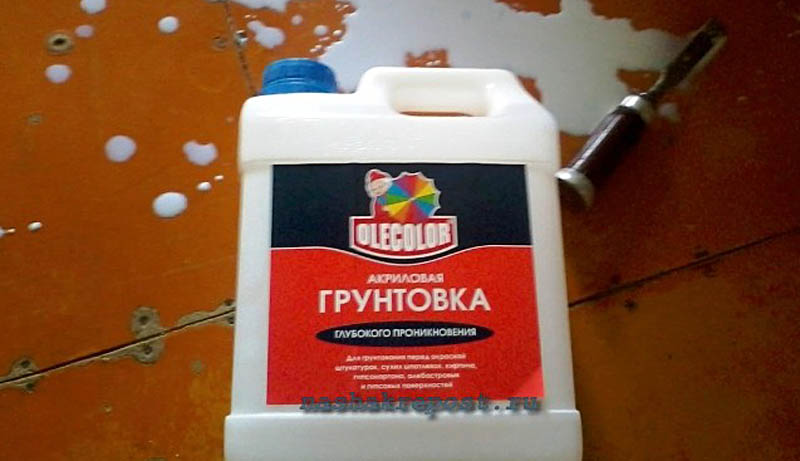
Universal primer
The white emulsion is suitable for painted plasterboard substrates, masks stained areas and evens out the shade of the coating.
Properties of mixtures
If you need a specialized primer for walls for any wallpaper, but which one to choose - there is no solution, pay attention to the characteristics:
- insulation. Resins, oils, adhesive soil components form a waterproofing film. Finished finish does not get wet even when washed;
- corrosion protection. Metal walls can be treated with a phosphating, passivating, tread compound. They create a film or fill the pores with zinc dust;
- mold resistance. This material serves to bond the surface and improve the quality of adhesion. It removes fungi or even eliminates them;

Primer for painting
The primer is used depending on the surface to be treated.
Most often, the manufacturer produces a concentrated mixture that must be diluted in certain proportions.
The produced mixtures can be divided into two main categories: adhesive - improving the adhesion of paint to the base, strengthening - to strengthen loose (porous) surfaces.
There is a so-called universal mixture, which combines all the necessary qualities in any climatic conditions. But it is also necessary to take into account the type of coating with which the surface will subsequently be covered.
So, you can distinguish some types of soil for painting:
- Reinforcing impregnations (acrylic water dispersion) with additives. Main purpose - interior work for application to cement-lime surfaces, drywall and gypsum plaster. It is considered universal, it forms a moisture-proof, but vapor-permeable film;
- Acrylic primers are designed for deep penetration. Creates a water-repellent base;
- Primer paints (acrylic and latex) are used as a base for acrylic and water-based coatings. Can be applied internally and externally;
- Solvent-based mix for outdoor and indoor use for surface hardening and waterproofing. It is deeply absorbed and can be applied to plaster, previously painted and asbestos-cement walls;
- Silicate primers are best applied externally to cover concrete, plastered walls, sand-lime bricks.
They are used before the silicate coating is applied. They are perfectly absorbed, closing up microcracks;
- Two-component epoxy paints are used internally for concrete walls. They are based on water.
So, the purpose of the strengthening soil is to create a non-peeling vapor-permeable film, and the task of the adhesive mixture is deep penetration without creating a film.
Can I be primed with glue?
For heavy vinyl wallpaper, this priming method is not very suitable, but for non-woven wallpaper with a thin layer or none at all, it is quite acceptable. True, the glue will be required one and a half times more than usual. For the primer, we dilute the glue in warm water according to the usual scheme, but pour the water itself twice as much.
Pour the dry mixture in a thin stream with continuous stirring.
We leave the resulting composition alone for 10 minutes, then mix thoroughly again. Apply liquid glue to the walls with a roller, spreading it over the surface in a thin layer without the formation of smudges
This usually takes 8 to 12 hours at normal room temperature. With all the simplicity of this method, you need to remember that it is only suitable for even and strong walls.
Having completed the priming work, you need to check the quality of their performance again. To do this, it is enough to slide your palm over the surface. The absence of grains of sand or traces of putty will be a sure sign that the job has been completed successfully, and you can confidently start gluing non-woven wallpaper.
Additional Information:
- walls treated with primer do not support the spread of mold and mildew;
- impregnation provides better adhesion - the wallpaper will adhere firmly to the wall;
- the treated surfaces have a higher moisture resistance, which also ensures a strong adhesion of the wallpaper to the wall, even at high humidity;
- the primer smoothes small unevenness of the wall and eliminates excessive porosity of the surface.
Priming the walls in the first place prevents premature peeling of the wallpaper. After all, it will be very sorry for the work spent, when the owners, already pacified by the end of the repair, will notice that the wallpaper, glued with such diligence, is moving away or bubbling in some places. Such a “surprise” will ruin any mood.
After all, re-gluing wallpaper is an additional cost and wasted time. Do I need to prime the walls before wallpapering, let's try to explain it in the next paragraph.
Thousands of skeptics will object: “fathers and grandfathers did not know what a primer was, and wallpaper hung on the walls for tens of years”.They are partly right. Indeed, a few decades ago, if the walls were primed, they did it either with very liquid homemade glue, or used diluted PVA glue.
Like any finishing material, the wallpaper should hold firmly and not turn yellow over time. For this, acrylic and alkyd compounds, latex compositions and even a solution of wallpaper glue are used. If the walls of drywall are not pre-treated with soil, then subsequently the wallpaper will have to be removed along with a putty or a protective layer of drywall panels.
Therefore, the preparation of the walls must be done.
- Relatively flat. Wallpaper will hide minor defects; but serious irregularities will still be noticeable. Note: matte, textured and contrasting wallpaper conceals irregularities; glossy, smooth and monochromatic - emphasize.
- Devoid of dust.
With a deep penetration primer, the wall should be treated in several layers. Each subsequent layer is applied only after the previous one has completely dried. Deep penetration solutions can take a long time to dry.
Therefore, it is recommended to adhere to the technical requirements when working with these materials, especially if you are doing repairs yourself.
A family of acrylic primers suitable for most types of surfaces, including concrete, brick, wood, plaster and putty. They dry quickly, do not have a pungent odor, and are best suited for drywall. Depending on the material of the wall surface, you can choose:
When choosing an acrylate primer, you can see the designations: strengthening, deep penetration, universal, adhesive, with antiseptic additives, etc. You can get confused from such a variety. What primer should I use before painting the walls? But it's actually pretty simple: the names speak for themselves.



